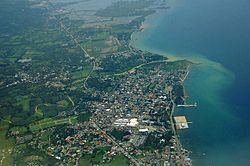Barangay Area 107.3 km² | District 5th district of Cebu Time zone PHT (UTC+8) Local time Thursday 6:46 AM | |
 | ||
Founded encomiendaParishMunicipalityCityhood 1570160917737 June 1961 Weather 25°C, Wind N at 14 km/h, 88% Humidity Neighborhoods Danasan, Tuburan Sur, Guinsay, Guinacot, Quisol | ||
Danao is a 3rd city income class component city in the province of Cebu, Philippines. According to the 2015 census, it has a population of 136,471. In the 2016 electoral roll, it had 86,085 registered voters.
Contents
- Map of Danao City Cebu Philippines
- History
- Barangays
- Demographics
- Mitsumi
- Holiday industry
- Gun industry
- References
Map of Danao City, Cebu, Philippines
Danao lies within Metro Cebu area.
History
The area of what is now Danao used to be the Cebuano Kingdom of Nahalin before the conquest of Cebu by the Spanish starting in 1565. In 1570 it became an ecomienda or a farmland controlled by certain Spanish officials, only to be abolished in the 18th century as abuses to the native workers became apparent. In 1609 Danao was made a parish by the Recollects, and much later in 1773 it officially became a municipality.
Much physical changes occurred in Danao as it went and passed through the 20th century. Mining, cement making and gun making industries made the once sleepy town of Danao so prosperous that in 1961 a national charter was passed to convert it into a city.
Barangays
Danao City comprises 42 barangays:
Demographics
In the 2016 electoral roll, it had 86,085 registered voters, meaning that 63% of the population are aged 18 and over.
Mitsumi
In Maslog, Mitsumi is one of the largest employers in northern Cebu.
Holiday industry
Tourism is still at its infancy. All along the eastern seaboard of Cebu there are plenty of family-owned resorts. They generally have no facilities; that part of the coast has no beach, and the water is not clean to swim.
There are a few good resorts, such as El Salvador in Sabang, which are large enough to hold conferences during the week, weddings at the weekend. They can bring in large amounts of income into the local economy.
Gun industry
Danao City was well-known for its gun industry. The industry started around 1905–1906. When World War II came, the Danao gunsmiths went underground, joined the guerrilla movement or were inducted into the USAFFE. Their main task was to re-chamber the Japanese Arisaka rifles to fit the US .30 caliber round or to keep the original Japanese rifle in good service.
The industry went on, still underground. In the 1960s, the term paltik was given to the homemade (and illegal) guns. In the early 1990s the industry was legalized by the government, with the creation of two organizations of local gunsmiths. The organization now left with proper permit is Workers League of Danao Multi-purpose Cooperative (World MPC), in Dungguan, Danao City.
World MPC was incorporated on October 1994 with twenty-five initial members. In November 1996 it was given license to manufacture handguns from caliber .22 to .45 by the Philippine National Police (PNP). The organization had been a potent group in working for the legalization of gun-making industry in the country with the aim to upgrade the technology and skills of gun makers, to provide job security and additional revenue for the government. The gun-making industry in Danao was pioneered using brass or copper as materials. The Chairman of World MPC was in charge of the compliance of the requirements of the Firearms Explosives Security Service Agency and Guards Supervisory Section (FESSAGES) until his death in 2010 after which World MPC itself was then shutdown for non-compliance of FESSAGES policies.
